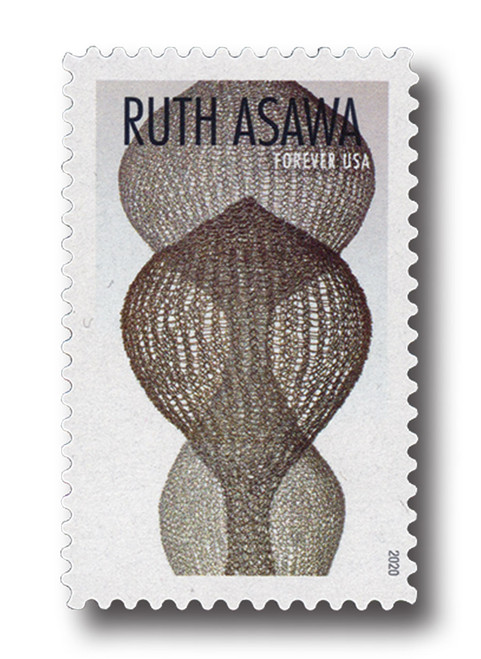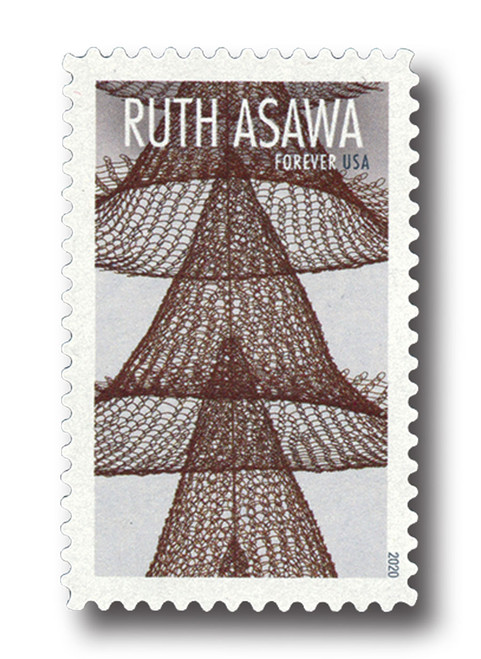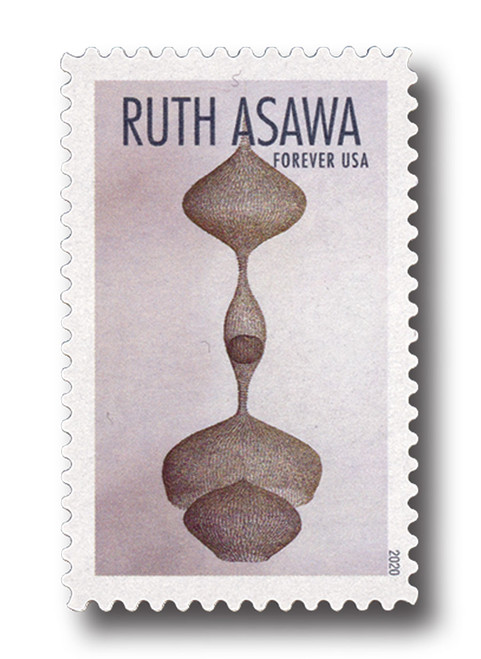
# 5507 - 2020 First-Class Forever Stamps - Ruth Asawa: Seven-Lobed Continuous Interlocking Form
US #5507
2020 Untitled Sculpture From 1955 – Ruth Asawa
- One of 10 stamps picturing different wire sculptures by Japanese- American artist Ruth Asawa
Stamp Category: Commemorative
Set: Ruth Asawa
Value: 55¢ First Class Mail Rate (Forever)
First Day of Issue: August 13, 2020
First Day City: San Francisco, California
Quantity Issued: 18,000,000
Printed by: Banknote Corporation of America
Printing Method: Offset
Format: Panes of 20
Tagging: Phosphor, block tag
Why the stamp was issued: To commemorate Japanese-American artist Ruth Asawa and her contributions to the art and education worlds.
About the stamp design: Pictures a photograph by Dan Bradica and Laurence Cuneo of a Ruth Asawa wire sculpture.
First Day City: The First Day of Issue Ceremony was held virtually due to the Covid-19 pandemic. The First Day of Issue postmark was from San Francisco, California, home to the Ruth Asawa San Francisco School of the Arts.
About the Ruth Asawa set: Includes 10 stamps picturing photographs by Dan Bradica and Laurence Cuneo of different Ruth Asawa wire sculptures. The set celebrates Asawa’s art as well as her contributions to the field of education. It also honors the hardships she endured as a Japanese-American US citizen during and after World War II.
History the stamp represents: Ruth Asawa is best known for her intricate wire sculptures. She was fascinated by the “possibilities of transforming cold metal into shapes that emulate living organic forms.”
Asawa was inspired to weave wire following a trip to Mexico in 1947. During that trip, she had watched local artists crochet egg baskets. She was intrigued by their technique and the way they took flat materials and transformed them into three-dimensional objects.
Upon returning home, Asawa adopted this weaving technique using wire, which was available in abundance on the farm where she lived. While she began weaving baskets, she soon started using the wire to recreate her own drawings as well as objects from nature.
Asawa’s sculptures usually began with a center stem with anywhere from 200 to 1,000 wires. These wires then branched out into geometric forms. Both the inside and outside of her sculptures were visible. The sculptures enclosed the space without concealing it. When hung from the ceiling, the shadows they cast became part of the artwork itself. This was often considered the hallmark of her work.
Asawa saw her work as a way of drawing in space – which could only be done with a line, because, as she stated, “a line can go anywhere.”
US #5507
2020 Untitled Sculpture From 1955 – Ruth Asawa
- One of 10 stamps picturing different wire sculptures by Japanese- American artist Ruth Asawa
Stamp Category: Commemorative
Set: Ruth Asawa
Value: 55¢ First Class Mail Rate (Forever)
First Day of Issue: August 13, 2020
First Day City: San Francisco, California
Quantity Issued: 18,000,000
Printed by: Banknote Corporation of America
Printing Method: Offset
Format: Panes of 20
Tagging: Phosphor, block tag
Why the stamp was issued: To commemorate Japanese-American artist Ruth Asawa and her contributions to the art and education worlds.
About the stamp design: Pictures a photograph by Dan Bradica and Laurence Cuneo of a Ruth Asawa wire sculpture.
First Day City: The First Day of Issue Ceremony was held virtually due to the Covid-19 pandemic. The First Day of Issue postmark was from San Francisco, California, home to the Ruth Asawa San Francisco School of the Arts.
About the Ruth Asawa set: Includes 10 stamps picturing photographs by Dan Bradica and Laurence Cuneo of different Ruth Asawa wire sculptures. The set celebrates Asawa’s art as well as her contributions to the field of education. It also honors the hardships she endured as a Japanese-American US citizen during and after World War II.
History the stamp represents: Ruth Asawa is best known for her intricate wire sculptures. She was fascinated by the “possibilities of transforming cold metal into shapes that emulate living organic forms.”
Asawa was inspired to weave wire following a trip to Mexico in 1947. During that trip, she had watched local artists crochet egg baskets. She was intrigued by their technique and the way they took flat materials and transformed them into three-dimensional objects.
Upon returning home, Asawa adopted this weaving technique using wire, which was available in abundance on the farm where she lived. While she began weaving baskets, she soon started using the wire to recreate her own drawings as well as objects from nature.
Asawa’s sculptures usually began with a center stem with anywhere from 200 to 1,000 wires. These wires then branched out into geometric forms. Both the inside and outside of her sculptures were visible. The sculptures enclosed the space without concealing it. When hung from the ceiling, the shadows they cast became part of the artwork itself. This was often considered the hallmark of her work.
Asawa saw her work as a way of drawing in space – which could only be done with a line, because, as she stated, “a line can go anywhere.”















